Annotations
Annotations are glyphs displayed on top of images to depict the presence of known sky objects, like galaxies, bright stars and so on. They come from catalogues but can only be displayed on images for which we know which part of the sky they represent, images that have been plate solved and contain the world coordinate system (WCS) information in their header, so only FITS or Astro-TIFF files.

View of full annotated image
Plate solving, can be done within Siril in the menu entry, or using external tools like astrometry.net or ASTAP.
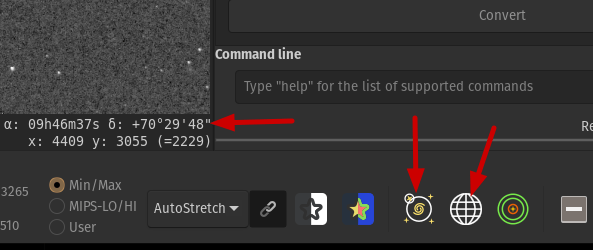
Buttons for annotations
When a plate solved image is loaded in Siril, you can see the sky coordinates for the pixel under the mouse pointer displayed at the bottom right corner and the buttons related to annotations become available. The first button toggles on or off object annotations, the second the celestial grid and the compass.
Offline annotation catalogues
Siril comes with a predefined list of catalogues for annotations:
Messier catalogue (M)
New General Catalogue (NGC)
Index Catalogue (IC)
Lynds Catalogue of Dark Nebulae (LdN)
Sharpless Catalogue (Sh2)
Star Catalogue (3661 of the brightest stars)
In addition, 2 user defined catalogues can be used:
User DeepSky Objects Catalogue (DSO)
User Solar System Objects Catalogue (SSO)
They are populated with the commands described in the section about searching for a known object.
They are stored in the user settings directory. Their location depends on the operating system:
for Unix-based OS they will be in
~/.config/siril/catalogueon Windows they are in
%LOCALAPPDATA%\siril\catalogue.
All of the above catalogues can be enabled/disabled for display in the tab.
The two user defined catalogues can also be purged (i.e. deleted) via the appropriate buttons.
A slider on the right side, allows you to easily navigate across the catalogue list.
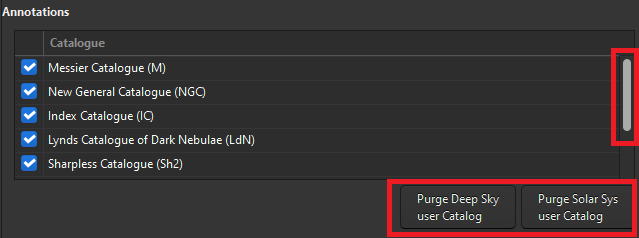
Catalogue management in Preferences/Astrometry
These annotation catalogues are used primarily for display purposes. Starting from Siril 1.3, they are also used to locate the center of the image for astrometry tool. If the object is found locally, the resolver will be shown as Local. If not, it will fall back using an online resolver.
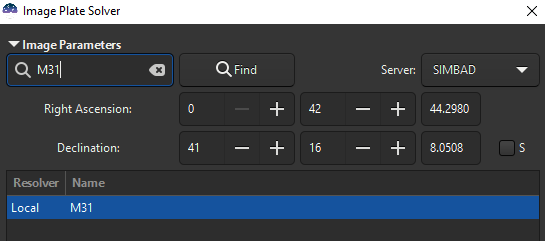
Object resolved from local annotations catalogues
Online annotation catalogues
You may want to query other databases than the ones already shipped with Siril, described in the offline annotation catalogues section. This works, again, for plated-solved images only.
Starting from Siril 1.3, this is possible with the command conesearch.
This new command replaces and expands capabilities previously provided by nomad
and solsys from Siril 1.2.
Siril command line
conesearch [limit_magnitude] [-cat=] [-phot] [-obscode=] [-tag={on|off}] [-log={on|off}] [-trix=] [-out=]
Todo
To be expanded when we have the new UI elements
The table below lists all the catalogues that are available, alongside links to the original data.
Catalogue |
-cat= |
Reference |
|---|---|---|
Local |
Omitted |
|
Tycho2 |
tycho2 |
|
Nomad |
nomad |
|
GAIA DR3 |
gaia |
|
PPMXL |
ppmxl |
|
Bright Stars Catalogues |
bsc |
|
APASS DR9 |
apass |
|
GCVS |
gcvs |
|
VSX |
vsx |
|
SIMBAD |
simbad |
|
PGC/HYPERLEDA |
pgc |
|
Exoplanet archive |
exo |
|
AAVSO VSP |
aavso_chart |
|
IMCCE Solar system skybot |
solsys |
The following queries are brought to you thanks to:
Vizier (through CDS Vizier TAP query service)
Simbad (through CDS Simbad TAP query service)
IMCCE (through its skybot conesearch service)
NASA exoplanet archive (though its TAP query service)
For solar system object queries, you may pass an additional parameter -obscode=, the 3-symbol code for an IAU observatory close by to your observing location. This will improve annotations accuracy. Please note that results may still slightly differ from those obtained by making a direct ephemerides query for a specific object, which uses the exact observing location (if present in the FITS header).
Tip
A preferred observatory code may be set in the Astrometry tab in the Preferences dialog. If set, this will be used for the Solar System Objects GUI tool and will also be used in the conesearch command unless the -obscode= argument is provided.
These additional annotations will be displayed in RED, to differentiate them
from offline annotations, shown in GREEN. These annotations will be erased as
soon as the Show Objects names button is toggled.
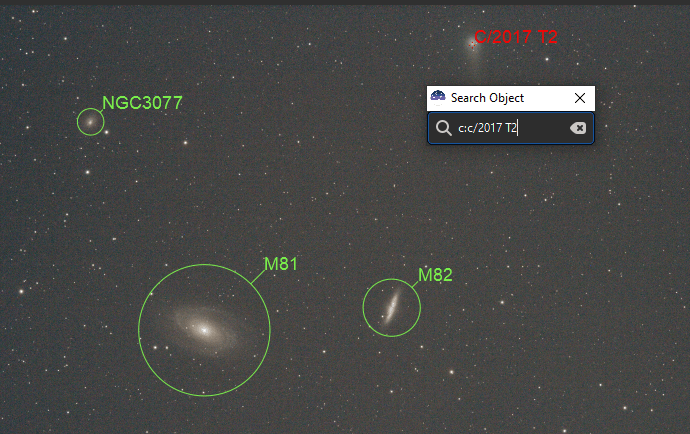
Result of a Search Solar System process
Extra catalogues
You may want to display your own user catalogues. This can be done with the
command show. This command can also be used to display, for instance,
csv files created with the feature to find
comparison stars.
Siril command line
show [-clear] [{ -list=file.csv | [name] RA Dec }] [-nolog] [-notag]
These catalogues may be any csv (comma-separated) file, respecting the following rules:
comments lines if any, should start with a # sign
a line should be present at the top with the column names, comma separated
at least ra and dec columns should be provided, in decimal degrees.
the columns can be written in no particular order
other columns can be passed:
name (str)
diameter (double), the object diameter in arcmin
mag (double), the object magnitude
type (str), which will be appended between () after the name in the Console
Other columns than those listed above may be passed but they will not be used.
List of known user catalogues:
Sometimes, users create their own catalogues, we can try to link them here to help everybody.
Variable stars, extracted from GCVS 5.1, discussed here in French, (
file link).
Warning
Contrarily to the instructions discussed in the linked topic, it is not recommended to replace the user-DSO catalogue with such files. The usage is discouraged as some of them could be particularly big and would slow down tremendously every annotation redraw.
Search for a known object
If you know a specific object is somewhere in the image (if not, see the search for an unknown object section), it is possible to add it to annotations.
Deep-sky objects
Load a plate-solved image and type Ctrl+Shift+/ or Search Object... in the menu .
A small search dialog will appear where object names can be entered. Pressing Enter will first search for this name the existing annotation catalogues in case it already exists under another name. If not it will send an online request to SIMBAD to get the coordinates of an object with such a name. If found, and not already in any catalogue, the object will be added to the Deep Sky user catalogue.
The items of this catalogue are displayed in ORANGE while the objects from the predefined catalogues are displayed in GREEN.
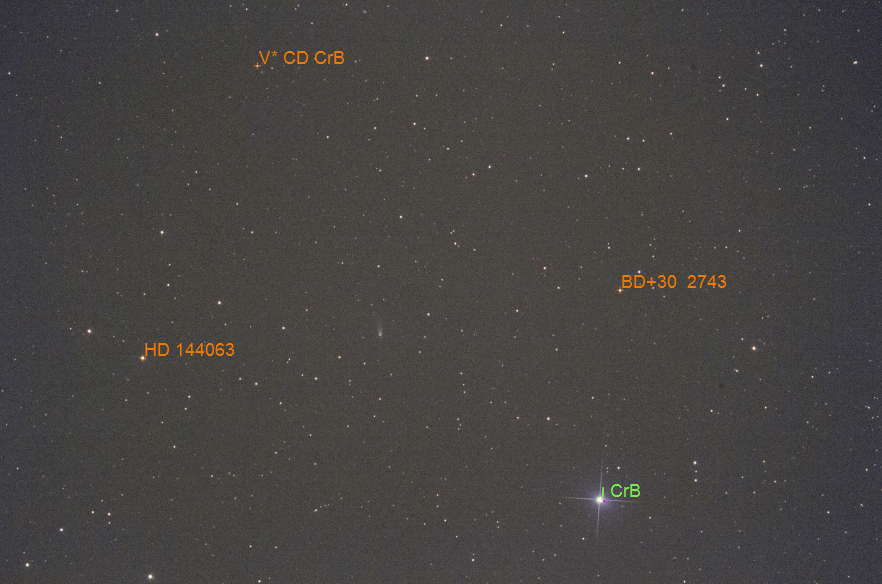
Deep sky objects from user and predefined catalogues
Examples of valid input (not case sensitive):
HD 86574orHD86574are both valid for this star
Solar-system objects
From Siril version 1.2, objects from the solar system can also be searched for,
using the Miriade
ephemcc
service. This is done in the same manner as for Deep Sky Objects, but
prefixing the name of the object to be searched
by some keyword representing the type of object: a: for asteroids,
c: for comets, p: for planets, dp: for dwarf planets and
s: for natural satellites.
If you query an image taken from a close enough date and time (same night) than
another image already annotated with SSOs, their cached positions
will be used and corrected by each object velocity as returned by the ephemerids.
The items of this catalogue are displayed in YELLOW.
Examples of valid inputs (not case sensitive):
c:67porc:C/2017 T2are valid forms for cometsa:1anda:ceresare both valid for (1) Ceresa:2000 BY4is valid for 103516 2000 BY4p:4orp:marsare both valid for Marsdp:Plutois valid for Plutos:Moonors:Iois valid for natural satellites.
Warning
Images that do not have a DATE-OBS header key cannot be annotated for SSOs.
Images that do not have observer location information (SITELAT, SITELONG and
SITEELEV header keys) will still be annotated, but assuming a geocentric
observer position, i.e. as if observing from center of the Earth. Depending
on objects distance wrt. Earth, this may result in positions being slightly
offset from their real positions.
Command catsearch
The same feature is accessible through the command catsearch:
Siril command line
catsearch name
Search for an unknown object
Especially useful for photometry works, it is possible to identify a star or other objects in the image by drawing a selection around them, right clicking to bring up the context menu, and selecting the PSF entry.
This will open the PSF window, and if it is a star it will display the Gaussian fit parameters, but it will also display a Web link at the bottom left of the window. Opening it will bring you to the SIMBAD page for the coordinates of the object and in many cases will give you the name of the object.
SIMBAD does not have all known objects, but the coordinates from the page can still be used as a starting point to look for the object in other online catalogues, for example Gaia DR3 (VizieR).